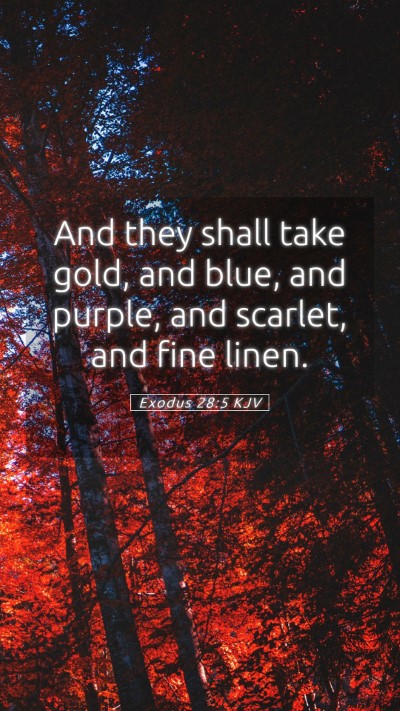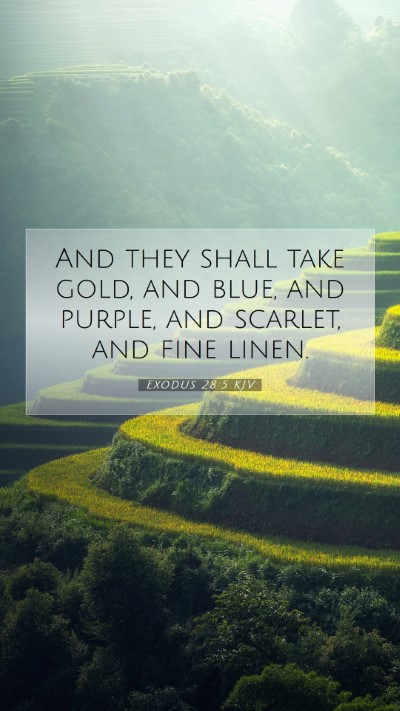Exodus 28:5 - Bible Verse Meaning and Interpretation
Exodus 28:5 states: "And they shall take gold, and blue, and purple, and scarlet, and fine linen." This verse is part of the instructions given to Moses regarding the garments of the priests, specifically, the high priest. Understanding this verse involves examining the materials used for the priestly garments, which symbolize various aspects of God's character and the role of the priest in mediating between God and His people.
Commentary Insights
Matthew Henry's Commentary
Matthew Henry emphasizes that the colors and materials mentioned in this passage are significant, representing the glory and majesty of God. The use of gold signifies divinity and purity, while the blue, purple, and scarlet denote royal luxury and the sacred nature of the priestly office. Henry points out that these garments were to reflect the greatness of God and were essential for the high priest's role on behalf of the people.
Albert Barnes' Commentary
Albert Barnes highlights the historical context of the materials chosen. He notes that blue symbolizes heaven, purple signifies royalty, and scarlet represents sacrifice. Barnes elaborates that the combination of these colors signifies the multifaceted role of the priest—a servant of God, an emperor of the earth, and a mediator of sacrifices. This reflects the function of the high priest as it relates to both worship and atonement.
Adam Clarke's Commentary
Adam Clarke provides further insight, stating that the fine linen was not just any fabric; it was a representation of righteousness and holiness, appropriate for those who serve in sacred duties. He explains that the high priest's garments are an integral aspect of worship and represent a commitment to God’s holy standards. Clarke's emphasis on the importance of the priest's attire sheds light on the instructions as sacred and purposeful.
Symbolism of Materials
- Gold: Symbolizes the divine nature and glory of God, representing purity and holiness.
- Blue: Represents heaven and the divine origin of the priest’s authority.
- Purple: Indicates royalty and the priest's representative status before God and the people.
- Scarlet: Connects with sacrifice and atonement, reflecting the blood of sacrifices.
- Fine Linen: Represents purity and righteousness, emphasizing the holy character required in worship.
The Role of the Priest
The garments described in Exodus 28:5 serve not only as clothing but as a profound reminder of the high priest's responsibilities. They denote the high priest's role as a mediator, a representative of the people before God, and a symbol of God's holiness and glory. The preparation of these garments illustrates the seriousness of worship and the need for purity and reverence in coming before God.
Application of the Verse
For modern readers, understanding Exodus 28:5 extends beyond the historical context; it encourages a reflection on personal holiness and the pursuit of righteousness. As believers, it invites them to consider what it means to approach God in worship today. The symbolism of the high priest's garments can inspire individuals in their spiritual journeys, serving as a reminder to clothe themselves in righteousness and seek a deeper relationship with God.
Related Bible Verses
- Exodus 28:2 - Description of the high priest's glory and beauty.
- Leviticus 8:7-9 - The anointing and garments of the priests.
- 1 Peter 2:9 - The concept of a royal priesthood in the New Testament.
- Hebrews 5:1-4 - Discussion on the nature and role of priesthood.
- Revelation 1:6 - Believers made priests to serve God.
Conclusion
Exodus 28:5 is rich with meaning, calling for thoughtful interpretation and application. It serves as a foundational verse in understanding the nature of the priesthood and the calling for holiness in worship. By using the insights from various biblical commentaries, one can gain a deeper understanding of Scripture and apply these lessons to their daily lives. Through careful study of this verse and similar passages, believers can develop a richer spiritual life and a more profound understanding of their relationship with God.


